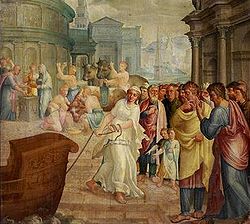
Claudia Quinta
Encyclopedia

Second Punic War
The Second Punic War, also referred to as The Hannibalic War and The War Against Hannibal, lasted from 218 to 201 BC and involved combatants in the western and eastern Mediterranean. This was the second major war between Carthage and the Roman Republic, with the participation of the Berbers on...
when Scipio Africanus
Scipio Africanus
Publius Cornelius Scipio Africanus , also known as Scipio Africanus and Scipio the Elder, was a general in the Second Punic War and statesman of the Roman Republic...
and Publius Sempronius
Tiberius Sempronius Longus (consul 218 BC)
Tiberius Sempronius Longus was a Roman consul during the Second Punic War and a contemporary of Publius Cornelius Scipio. In 218 BC, Sempronius was sent to Africa with 160 quinqueremes to gather forces and supplies, while Scipio was sent to Iberia to intercept Hannibal...
were consul
Consul
Consul was the highest elected office of the Roman Republic and an appointive office under the Empire. The title was also used in other city states and also revived in modern states, notably in the First French Republic...
s.
She was a woman that had a reputation of doing things in excess beyond what most Roman women did at the time. As an example, while she was always beautifully dressed, she did have an extensive wardrobe. Her makeup was excessive and she gave the appearance of extraordinary boldness. To the serious Roman women it presented an appearance that she was unchaste and dishonorable.
Around the year 205 BC the statue of the Cult of the Great Mother (also known as Magna Mater or the Cult of Cybele) was moved from Pessinus
Pessinus
Pessinus was a city in Anatolia, the Asian part of Turkey on the upper course of the river Sakarya River , from which the mythological King Midas is said to have ruled a greater Phrygian realm...
to Rome. Scipio Nassica was given the order to take all the married women of Rome to go and receive the statue when it arrived in port at Ostia Harbor
Ostia Antica
Ostia Antica is a large archeological site, close to the modern suburb of Ostia , that was the location of the harbour city of ancient Rome, which is approximately 30 km to the northeast. "Ostia" in Latin means "mouth". At the mouth of the River Tiber, Ostia was Rome's seaport, but, due to...
.
However before arriving in port as scheduled the ship carrying the statue ran onto a sandbar at the mouth of the Tiber River and would not proceed any further. They tied ropes to the stuck vessel and all the young men of the area were put into service. Using all their strength they pulled to no avail. They then called on Claudia to come up with a solution to their problem as she was the other person with Scipio that called the women to the port for the arrival of the statue. Claudia prayed in front of them and then with confidence she ordered that the ropes be tied to her sash
Sash
A sash is a cloth belt used to hold a robe together, and is usually tied about the waist. The Japanese equivalent of a sash, obi, serves to hold a kimono or yukata together. Decorative sashes may pass from the shoulder to the hip rather than around the waist...
and the men to step aside. Claudia then pulled and pulled until the vessel started floating again. She towed it out off the sandbar and into port. Needless to say, she instantly became a hero and had vindicated herself. The Temple of Cybele
Temple of Cybele (Palatine)
The Temple of Cybele or Temple of Magna Mater was a temple on the Palatine Hill in Rome. This, the main temple of Cybele or Magna Mater in Rome, was erected after the Roman embassy brought back her icon from Pessinus in 204 BC...
then went to the Palatine Hill
Palatine Hill
The Palatine Hill is the centermost of the Seven Hills of Rome and is one of the most ancient parts of the city...
in Rome.

